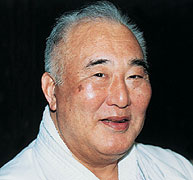|
Taiji Kase
Taiji Kase (加瀬 泰治, Kase Taiji, 9 February 1929 – 24 November 2004) was a Japanese master of Shotokan karate who was one of the earliest masters responsible for introducing this martial art into Europe.[1] He taught his style of karate, Shotokan Ryu Kase Ha, in France from the late 1960s to the mid-1980s.[1][2] In his later years, he travelled across the world teaching karate, but Paris remained his home.[3] Kase held the rank of 9th dan in karate.[4] Early lifeKase was born on 9 February 1929 in Chiba, Chiba Prefecture, Japan.[1][2][3][5][6][7][8][a] His father was Nobuaki Kase, who held the rank of 5th dan in judo.[6] He began learning judo before he turned 6 years old, and later in boyhood also studied aikido and kendo.[1] In 1944, at the age of 15 years, Kase attained the rank of 2nd dan black belt in judo.[1] That same year, he read a book on karate by Gichin Funakoshi, and was inspired to begin studying that art under Funakoshi himself.[1][2] He also trained under Funakoshi's son, Gigō Funakoshi, before the latter's death in 1945.[9] Genshin Hironishi took on most of the teaching duties from that point.[10] Along with Hironishi, Tadao Okuyama also influenced the young Kase's development in karate.[11] Of his four instructors, Hironishi taught him the longest—six years.[12] Kase had been due to be tested for his 3rd dan in judo, but elected to focus on karate instead.[1] Karate careerIn March 1945, during the closing stages of World War II, Kase enlisted in the Imperial Japanese Navy and joined the Kamikaze corps.[1][2] The war ended, however, before he was required to give up his life for his country.[1] One of his biographers, Martin Fernandez, wrote: "[Kase] usually says that since he could have died in the war and is alive, he never has a reason to be sad. And this is so, because you can always see him smiling or with a special inner mood" (p. 4).[1] The Shotokan dojo (training hall) had been destroyed by bombing, and he was unable to find another karate dojo, so he returned to training in judo for a while.[1] When the Shotokan students regrouped under Funakoshi, however, he rejoined them.[1] In 1946, Kase was promoted to 1st dan in Shotokan karate.[1][4] He began studying economics at Senshu University and, in 1949, became captain of the university's karate team.[1] That same year, he attained the rank of 3rd dan.[1][4] He graduated from Senshu University in 1951.[1][2] Kase joined the newly formed Japan Karate Association (JKA) with the aim of becoming a professional karate instructor,[2] and would later become Chief Instructor for the European branch of the JKA.[1] One of his duties in the JKA was to train instructors in kumite (sparring); amongst his students were Keinosuke Enoeda and Hiroshi Shirai[1] as well as Hideo Ochi. Following Funakoshi's death in 1957 and a subsequent division in the JKA, Kase maintained ties with both factions.[1][2] In 1964, Kase left Japan to introduce karate overseas. That year, he taught for three months in South Africa, and continued teaching there the next year with Enoeda, Shirai, and Hirokazu Kanazawa.[1] From 1965 to 1966, he taught in the United States of America, West Germany, the Netherlands, and Belgium.[1] In 1967, he taught with Shirai in Italy for several months, and then travelled to France, where he settled in Paris.[1][2] In 1968, Kase was coach of the French Karate Federation.[13] He went on to teach karate there for almost 20 years in France before deciding to close his dojo in the mid-1980s.[1][2] Amongst his European students was Steve Cattle, who founded the English Shotokan Academy.[14][15] He then began travelling around the world to teach karate.[1] Kase was frequently a guest of the former Yugoslav Karate Association, and almost all of the senior Yugoslav karate instructors gained their dan ranks through examinations in which he was involved.[citation needed] During his time in France, Kase wrote books on his martial art, including 5 Heian: Katas, Karaté, Shotokan (1974), 18 kata supérieurs: Karate-dô Shôtôkan Ryû (1982), and Karaté-dô kata: 5-Heian, 2-Tekki (1983).[16][17][18] Later lifeIn 1989, Kase and Shirai founded the World Karate-Do Shotokan Academy (WKSA).[1][6] Kase has called his style of karate "Shotokan Ryu Kase Ha,"[6][19][20] meaning Shotokan with Kase's personal touch.[1] Although he was travelling around the world promoting his style of karate, Paris remained his home.[3] Kase suffered a heart attack on 31 May 1999, but recovered at the American Hospital of Paris.[1][2] Following his recovery, he returned to teaching karate.[2] On 6 November 2004, Kase became critically ill, and was hospitalised.[21] He returned home later on, and appeared to be recovering, but on the morning of 19 November his wife was unable to wake him.[21] Kase had lapsed into unconsciousness, and was brought to hospital, but his condition only deteriorated.[21] Kase died at 5:25 PM on 24 November 2004,[5] leaving behind his wife and two daughters,[1][3][21] and his mother (then 101 years old) and two brothers.[21] His funeral was held at the crematorium of Père Lachaise Cemetery, Paris, on 30 November 2004.[3][5][21] Kase held the rank of 9th dan at the time of his death.[4] In June 2005, Kase's widow, Chieko Kase, became honorary President of the Kase Ha Shotokan Ryu Karate-Do Instructors' Academy.[22][23] One of their daughters, Sachiko, was in attendance at the ceremony.[23][b] See alsoNotesa. ^ Most sources give 9 February as Kase's date of birth,[3][5][6][7][8] but some sources give 9 January instead.[1][2] b. ^ One source lists some of Kase's family: Chieko Kase (wife), Yumiko and Kumihiko Inaba (daughter and son-in-law), Sachiko Kase (daughter), and Yusuke (grandson).[24] References
External links
|
||||||||||||||||||||||
